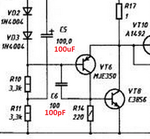Enzy
Advanced Member level 1
I build this amplifier circuit last-night I didnt add all the transistors I only added a pair for testing I used 2SC3856 and 2sa1216 for T1,T2 and T3 I used bc547 I didn't have any bc546. I supplied the board with 40v +/- I herd sound out of the amp when I connected it up but it was sounding bad like when am amp is getting low voltage or when the center tap leg isnt connected at the power supply stage what I realized is after as while a part of the board burned a little then I unplugged it, only a trace burned away slightly, what I realized is that I didnt add the 5 ohm resistor on the transistors so I did that and it didnt smoke after that but it still played bad, I touched one of the bc547 and realized it was warm, actually getting hot in a way. Across the collector and emitter I was getting about 38v and I was wondering if thats the problem since that voltage is close to the limit, the only other 2 things in the circuit which isnt correct is is I think c5 is 100pf and I used a 102 because I didn't have a 101 and also the 2 1n4004 in series with the 3.3k resistors I used 1n4007 instead and I used a power supply with regulators for testing puroses only not sure where my problem is I don't remember where I got this schematic it was either here or a next forum where it was said to be functional and tested.

I etched this circuit also I used photoshop and saved it back to Jpeg and it actually attacked 2 transistor legs up on saving the file, not until I etched the board and assembled the parts I realized that it did that some how.

I etched this circuit also I used photoshop and saved it back to Jpeg and it actually attacked 2 transistor legs up on saving the file, not until I etched the board and assembled the parts I realized that it did that some how.
